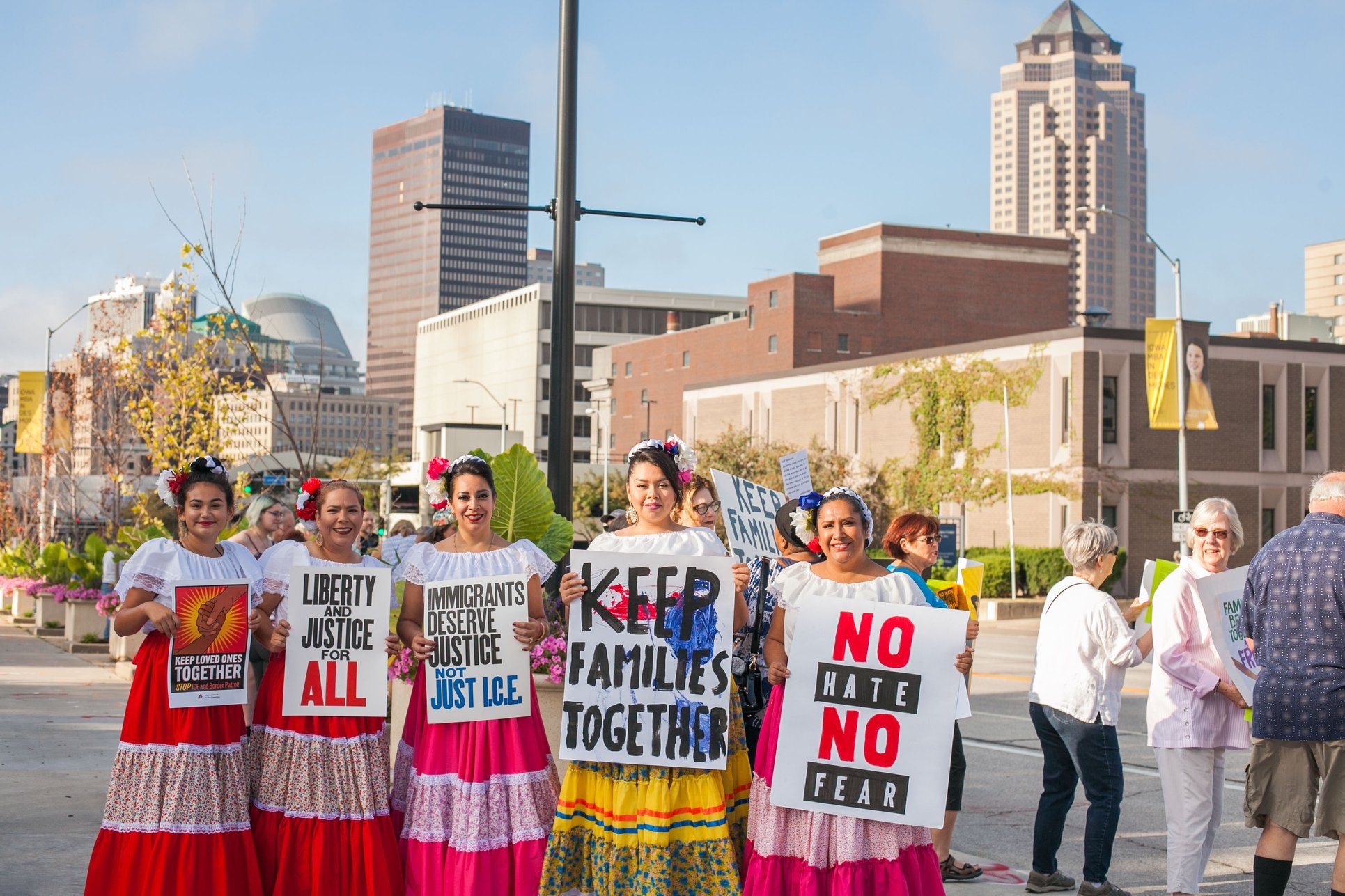
A protest in Iowa organized by Iowa Citizens for Community Improvement in partnership with AFSC. Iowa Citizens for Community Improvement / AFSC
The president continues to portray migrants and migration–including people traveling with a caravan for safety reasons–as a threat to the United States. Reporters, analysts, and even advocates may be unwittingly reinforcing this framing–and undermining humane treatment for all people.
Take action today: Tell Congress to protect asylum seekers!
Here’s how you should talk about the migrant caravan to avoid reinforcing these harmful messages:
1. Migrants are people who move–and they have human rights.
Always use inclusive language that doesn’t “other” migrants and that emphasizes our shared humanity and rights. Most of us move from where we were born; movement is a common part of the human experience.
2. Avoid water metaphors–people do not constitute a flood, flow, or wave.
The media commonly uses water metaphors to describe migrants and migrations, but this language is corrosive. Floods and tidal waves are mortal dangers–hard to contain–and using these terms to describe migrants helps reinforce the migration threat narrative. Migrants are people seeking a better life for themselves and their families–not flows of water.
3. Avoid these metaphors, too: A nation is not a "house." The U.S. is not being "invaded."
Most people understand politics through metaphors. One persistent metaphor imagines that the country is like a house: It has a door, a gate, and an owner who can welcome people in or keep people out. This tends to make people think that those who enter without permission are committing a crime or breaking in forcefully, which lowers support for a humane response.
Instead, research suggests using the metaphor of the nation as a body. Use language like “backbone of this country” or “vital to the nation” to elicit a more compassionate response.
In some egregious cases, reporters have described the migrant caravans as if they were an invading army, and we continue to see the use of words like “stormed.” President Trump has tweeted that people on previous caravans were criminals, and he often frames migrants as emissaries sent by hostile governments (“they're not sending their best,” for example)–perhaps as a pretext for suggesting a military response rather than a humanitarian one.
It’s important that we continue to emphasize that people who have joined the migrant caravan are traveling together because there is safety in numbers—and they are looking for the safety and peace we all want to live in. They deserve our empathy.
4. Seeking asylum is a right–and our system should treat all people with dignity and humanity.
There are many reasons why people leave home and seek a better life abroad. Rooted in post-World War II domestic and international laws, our system allows refugees to seek asylum in the United States if they are fleeing persecution. Many of the people in the migrant caravan are traveling here to escape violence and to seek asylum, something they have a legal right to do. Ensuring that the United States builds a fair and generous asylum system is critical.
But we must also build a system that treats all people humanely. People’s reasons for migrating are complex, and economic instability and violence are interconnected. We must therefore reject policies that criminalize migration more broadly, militarize our borders, and treat people like those in the migrant caravan with cruelty and brutality.
So, when talking about the migrant caravan, focus on humane treatment for all, not the narrow legality of asylum claims.
We often hear advocates and activists use the phrase “no human being is illegal.” But researchers have found that this language isn’t always effective in convincing the persuadable middle. Advocates should avoid using the word “illegal” because it has been used to dehumanize people. Instead, underscore our shared humanity: All people have the same rights.
5. Be careful about the language of crisis. Calling immigration a crisis feeds punitive and exclusionary polices.
The Trump administration often talks about migration as if it’s a crisis. This language makes immigration seem like a serious threat demanding a strong emergency response. But the fact is, migrants do not constitute an existential threat, even if white nationalists and nativists portray them as such. Don’t repeat the administration’s framing of immigration as a crisis.
That is not to say that nothing serious is happening. For people seeking refuge in the United States, the situation may feel like a personal crisis. The decision to leave one’s home due to life-threatening violence and poverty can never be undertaken lightly. And how the Trump administration is treating migrants and immigrants–including those arriving at the border and people who have made their lives in the United States–is creating a moral and humanitarian crisis. But that’s quite different than migration and migrants themselves being the source of crisis.
6. Don't share false and alarmist information on social media.
Retweeting or Facebook-sharing a harmful post only highlights it, making it more likely to stick in people’s minds, which can seriously hurt vulnerable communities.
So how can you tell if something you read on the internet is true? What should you do before you click share? Check out AFSC's guide to help you better assess the news you see on Facebook. Instead of retweeting or reply-tweeting harmful content, here’s what you can do.
We need to speak out against hateful, anti-immigrant language and policies at every chance we get. And it’s important that we ask our family, friends, and communities to do the same. All of us can show support for migrants and help build support for a compassionate response through our language and framing.

